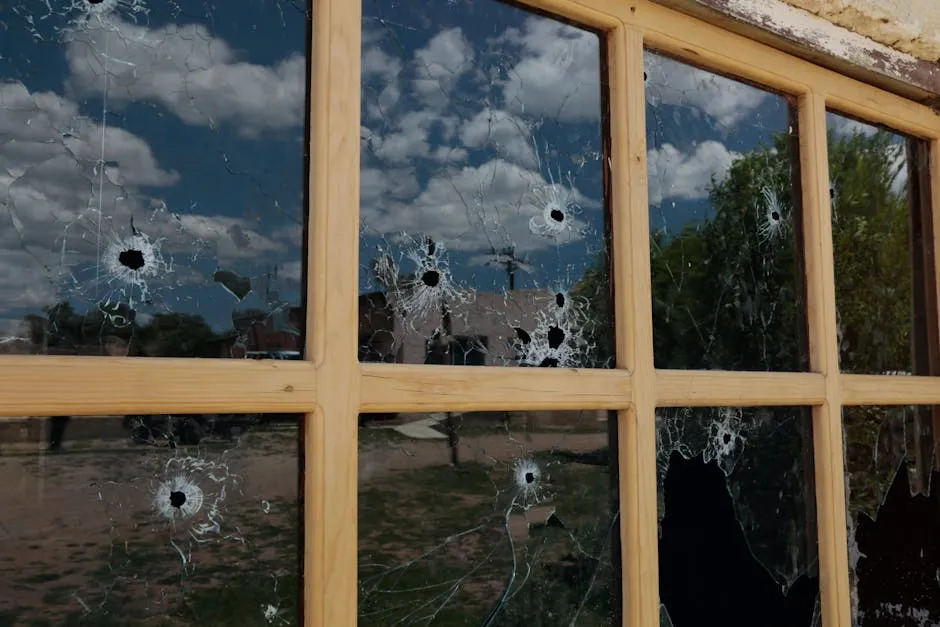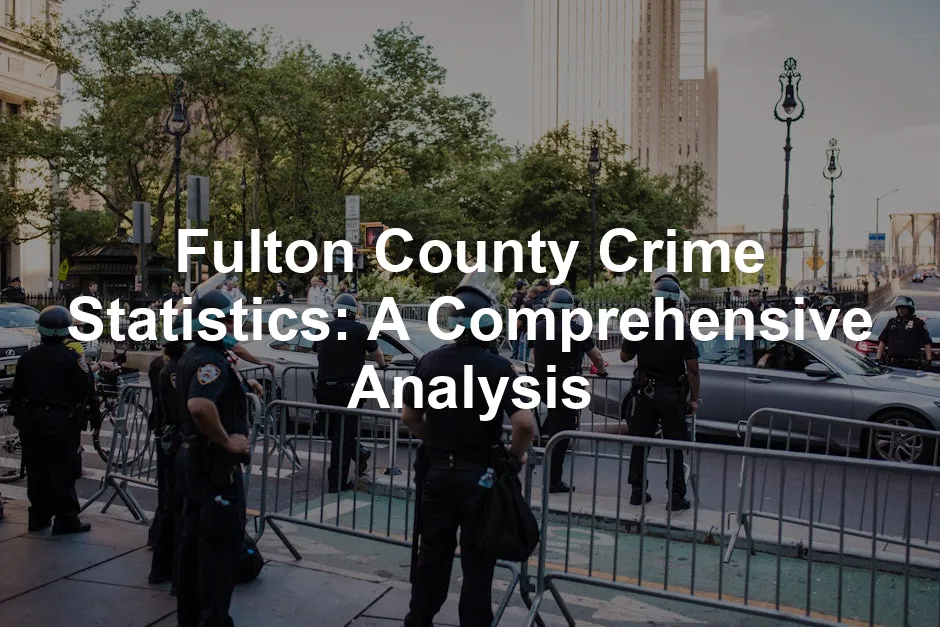Introduction
Crime statistics offer a vital lens into community safety. In Fulton County, understanding these numbers is crucial for residents and policymakers alike. With recent data showing a concerning rise in both violent and property crime rates, awareness is more important than ever.
The violent crime rate in Fulton County stands at 32.0, significantly higher than the national average of 22.7. Meanwhile, property crimes are even more alarming, with a rate of 63.3 compared to the national average of 35.4. These statistics might make you want to double-check your locks and perhaps invest in a good Smart Door Lock.
This article aims to provide a detailed analysis of crime statistics in Fulton County. By discussing trends, comparisons, and potential implications, we hope to arm you with the information you need. Understanding these figures can help foster informed discussions about community safety and crime prevention.
Whether you’re a long-time resident or new to the area, grasping the realities of crime is essential. After all, knowledge is power, and in this case, it might even save you from becoming a statistic.

Understanding Crime Statistics
What are Crime Statistics?
Crime statistics are numerical representations of crime data, compiled from law enforcement agencies. They provide insights into crime trends, helping communities understand their safety landscape. These statistics are crucial for analyzing societal issues and informing policy decisions.
Two primary categories exist in these statistics: violent and property crimes. Violent crimes include offenses like murder, assault, and robbery. These acts can lead to serious harm or death and have a profound impact on victims and communities. Property crimes, on the other hand, encompass burglary, theft, and motor vehicle theft. While these crimes might not directly threaten life, they can significantly erode community confidence and security.
Understanding the nuances of these crimes helps residents grasp the risks they face daily. For example, knowing that violent crime is rising might prompt you to be more vigilant when walking home at night. Conversely, awareness of property crime trends could motivate you to secure your home better. Speaking of security, consider installing Home Security Systems that can help you feel more secure at home.
In Fulton County, these crime statistics are not just numbers; they represent real impacts on real lives. Whether you’re a homeowner, a renter, or just passing through, understanding these statistics is key to navigating your safety in the community.

How Crime Statistics are Collected
Crime statistics are gathered mainly through law enforcement agencies. In the United States, the Uniform Crime Reporting (UCR) Program plays a central role. This program, managed by the FBI, collects data on serious crimes reported to law enforcement. Each participating agency submits reports detailing the number of offenses and arrests made. These reports help paint a clearer picture of crime trends across the nation.
While this method provides valuable insights, it has its limitations. One major concern is the issue of unreported crimes. Many victims choose not to report incidents for various reasons, such as fear of retaliation or a lack of faith in the justice system. This means that the official statistics may not fully represent the true extent of crime in a community. As a result, law enforcement agencies often rely on estimates to fill in the gaps. Understanding these nuances is essential for interpreting crime data accurately.
Fulton County Crime Overview
Current Crime Rates
Fulton County is grappling with alarming crime rates. The violent crime rate sits at 32.0, significantly above the national average of 22.7. This means that residents face a higher chance of encountering violent crime than in many other areas. Property crime is even more concerning, with a rate of 63.3 compared to the US average of 35.4. These statistics aren’t just numbers; they highlight a pressing issue for community safety.
The implications of these rates are profound. High crime rates can lead to heightened fear among residents, impacting their quality of life. People may avoid certain areas or stay indoors, reducing community engagement. The economic consequences can also be significant, with businesses facing losses due to theft or vandalism. This creates a cycle where fear and crime deter investment and growth. To combat this, consider investing in Window Security Film to protect your home from break-ins.

Breakdown of Violent Crimes
Understanding the types of violent crimes is necessary for addressing community safety effectively. In Fulton County, the violent crime categories include assault, robbery, and homicide. Assaults are the most common, often involving altercations that escalate unexpectedly. Robberies, where force or intimidation is used to steal, also contribute significantly to the crime rate. Homicides, while less frequent, are the most severe and receive extensive media coverage, further shaping public perception.
Comparing these categories to similar urban areas, like Atlanta, reveals a concerning trend. For instance, Atlanta’s violent crime rates are even higher, particularly in neighborhoods facing socio-economic challenges. This comparison emphasizes the need for targeted interventions and community programs aimed at reducing violence and fostering safety.
By breaking down these statistics, we can better understand the challenges Fulton County faces. This knowledge can drive discussions around effective crime prevention strategies and community involvement, ultimately leading to a safer environment for all residents.

Breakdown of Property Crimes
Fulton County grapples with various property crimes that impact residents daily. The primary types include burglary, theft, and auto theft. Each type presents unique challenges and contributes to the overall crime rate.
Burglary often involves breaking and entering, typically to commit theft. In Fulton County, it’s a significant concern. Residents may feel uncomfortable leaving their homes unattended, fearing a break-in. With a property crime rate of 63.3, which is well above the national average of 35.4, this concern is valid. To enhance your safety, consider a Home Surveillance DVR to monitor your property.
Theft encompasses a range of crimes, from shoplifting to pickpocketing. In urban areas like Fulton, petty theft can thrive in crowded places. It’s like trying to find a needle in a haystack; the hustle and bustle can make it easier for thieves to strike. To further protect yourself, consider carrying a Personal Safety Alarm that can help alert others in case of an emergency.
Auto theft is another alarming trend. With growing vehicle theft rates, drivers often find themselves looking over their shoulders or checking their locks twice. The fear of losing a car can put a damper on even the best of days. To protect your vehicle, think about a Anti-Theft Backpack that can keep your belongings secure while you’re on the go.
When we compare Fulton County’s property crime rates to nearby counties, the picture becomes clearer. For instance, neighboring South Fulton has a property crime rate of 26.38 per 1,000 residents, significantly lower than Fulton County’s. This stark difference highlights the urgent need for community awareness and safety measures.
Additionally, looking at cities like Atlanta, we can see the impact of urbanization. Atlanta’s property crime rate stands at 4,654.4 per 100k residents, making it one of the most affected areas in the state. It’s a reminder that higher population density can correlate with increased crime rates.
Residents are encouraged to stay vigilant. Simple precautions, such as securing doors and windows and investing in Motion Sensor Lights, can help mitigate risks. Community initiatives, like neighborhood watch programs, can also play a vital role in crime prevention.
By understanding these property crime trends, Fulton County residents can take informed steps toward enhancing their safety and community well-being.

Historical Trends in Crime
Crime Rate Changes Over the Years
Fulton County’s crime statistics tell a compelling story of fluctuating crime rates over time. Historical data reveals both significant increases and decreases in various crime categories, reflecting broader social dynamics.
In the past decade, violent crimes have seen a noticeable uptick. For example, the violent crime rate rose from 28.5 to 32.0 in recent years. This increase signals a growing concern for residents. Factors contributing to this rise may include economic challenges and social unrest, which often correlate with crime spikes.
Conversely, certain property crimes have shown a decline. Burglary rates, for instance, dropped from 12.3 incidents per 1,000 residents to 10.5. This decrease may be attributed to enhanced law enforcement efforts and community awareness programs. Residents are becoming more proactive in safeguarding their homes.
Analyzing specific years reveals even more trends. In 2018, a significant spike in auto thefts occurred, peaking at an alarming rate. Experts suggest that this spike was influenced by a surge in carjackings and the rise of gangs. In contrast, 2020 saw a drop in property crimes overall, likely due to pandemic-related lockdowns.
However, the statistics should be interpreted cautiously. Crime rates can be influenced by various factors, including economic conditions, community engagement, and law enforcement strategies. For example, increased police presence can lead to a rise in reported crimes, as more incidents come to light.
Understanding these historical trends equips residents and policymakers with the insights needed to foster safer communities. Continuous monitoring of crime statistics is essential for developing effective strategies to combat crime and improve community safety.
In conclusion, crime trends in Fulton County reveal a complex landscape. By analyzing historical data, we can identify patterns and devise collaborative efforts to address safety concerns. Staying informed is key to fostering a resilient community capable of facing challenges head-on.

Case Studies: Notable Years
Fulton County has seen its share of crime statistics that could rival a roller coaster ride. Some years have brought alarming spikes, while others showcased a welcome decline. For instance, in 2018, the violent crime rate surged, raising eyebrows and prompting discussions about community safety. Economic downturns often correlate with such spikes. Financial strain can lead to desperation, and sadly, crime rates tend to climb.
Conversely, 2020 marked a notable drop in property crime. With pandemic lockdowns in full swing, fewer people were out and about, leading to less opportunity for crime. This peculiar trend illustrates how external factors, like health crises, can impact crime statistics.
These case studies highlight the importance of understanding the broader context behind crime data. It’s not just about numbers; it’s about people, policies, and the community’s response.
Crime Comparisons with Neighboring Areas
Crime in Nearby Cities
To put Fulton County’s crime statistics into perspective, let’s compare them with nearby cities. The table below highlights the differences in crime rates:
| City | Violent Crime Rate (per 100k) | Property Crime Rate (per 100k) | Population | Data Year |
|---|---|---|---|---|
| Fulton County | 32.0 | 63.3 | 1,065,000 | 2023 |
| Atlanta, GA | 768.8 | 4,654.4 | 430,066 | 2018 |
| South Fulton, GA | 10.45 | 26.38 | 107,000 | 2022 |
| Brookhaven, GA | 387.3 | 2,444.6 | 54,734 | 2019 |
As seen in the table, Atlanta’s violent crime rates are significantly higher than those in Fulton County. This stark contrast can be attributed to factors like population density and socioeconomic conditions. Atlanta, being a bustling metropolis, naturally attracts more crime opportunities.
Meanwhile, South Fulton boasts lower crime rates, likely due to its smaller population and community initiatives. Understanding these dynamics helps contextualize Fulton County’s statistics. To further enhance community safety, consider forming a Neighborhood Watch Sign to deter potential criminals.

Comparison with Similar Size Cities
Now, let’s expand our scope and compare Fulton County’s crime statistics with similarly sized cities across the U.S.
| City | Violent Crime Rate (per 100k) | Property Crime Rate (per 100k) | Population | Data Year |
|---|---|---|---|---|
| Nashville, TN | 1,073.1 | 4,041.1 | 564,169 | 2019 |
| Charlotte, NC | 739.4 | 3,925.8 | 604,931 | 2019 |
| Jacksonville, FL | 647.4 | 3,309.5 | 790,972 | 2019 |
| Louisville, KY | 686.9 | 3,891.5 | 677,710 | 2019 |
Fulton County’s violent crime rate of 32.0 per 100k is far below that of cities like Nashville and Charlotte. This indicates a more favorable safety profile for Fulton County residents. The lower rates may stem from effective community policing efforts and crime prevention initiatives. To stay safe, consider equipping yourself with a Tactical Flashlight for those unexpected situations.
In conclusion, comparing crime statistics across neighboring areas and similarly sized cities provides valuable insights into Fulton County’s safety landscape. It helps residents understand their community better and can guide local leaders in addressing safety concerns. Awareness can make all the difference!

Community Impact
Effects of Crime on Residents
Crime affects how residents perceive their community. Rising crime rates can lead to feelings of fear and insecurity. When neighbors hear about local thefts or assaults, it can shatter their sense of safety. Suddenly, that evening stroll or trip to the grocery store feels like a high-stakes adventure.
The impact on quality of life is profound. Families may avoid certain areas, leading to diminished community engagement. Local businesses can suffer as foot traffic declines. Think of it as an unwelcome guest that overstays its welcome and disrupts the party. To feel more secure, you might consider keeping a Pepper Spray handy just in case.
But communities don’t just sit back and accept this unwelcome change. Many residents band together to take action. Neighborhood watch programs spring up like daisies in spring. These initiatives empower citizens to keep an eye on each other. The idea is simple: safety in numbers!
Local initiatives also emerge, focusing on crime reduction. Workshops on home safety, self-defense classes, and community events help foster connections. People start to talk more, share information, and look out for one another. This proactive approach helps restore a sense of control and safety.
Ultimately, crime influences not just statistics but the very fabric of community life. It challenges residents to adapt, respond, and work together. When neighbors unite, they can turn fear into strength, creating a safer environment for everyone.

The Role of Law Enforcement
Local law enforcement plays a pivotal role in combating crime and restoring peace. The effectiveness of police in addressing crime rates can vary. Some officers excel at community engagement, building trust and rapport. Others might focus on traditional methods, leading to mixed results.
Community-police partnerships are vital. When law enforcement collaborates with residents, it fosters transparency and accountability. Programs like “Coffee with a Cop” allow citizens to interact with officers in a relaxed setting. These informal chats can break down barriers and build relationships.
Moreover, police departments often implement crime prevention strategies tailored to specific neighborhoods. This can include targeted patrols in high-crime areas or outreach programs aimed at youth. Engaging young people can deter future criminal behavior and promote positive activities.
Feedback from the community also matters. When residents voice their concerns, police can adjust their tactics accordingly. Whether it’s addressing loitering or increased patrols, this communication loop is essential.
Ultimately, the collaboration between law enforcement and the community can lead to tangible results. When residents feel heard and valued, they’re more likely to cooperate with police efforts. This synergy can significantly impact crime rates, making neighborhoods safer for everyone.
In conclusion, addressing crime in Fulton County requires a continuous effort from both the community and law enforcement. By working together, they can cultivate a safer environment that nurtures trust and resilience among residents.
For more detailed insights into crime statistics in the area, you can check out this comprehensive analysis of Fremont crime statistics.
Please let us know what you think about our content by leaving a comment down below!
Thank you for reading till here 🙂
All images from Pexels




